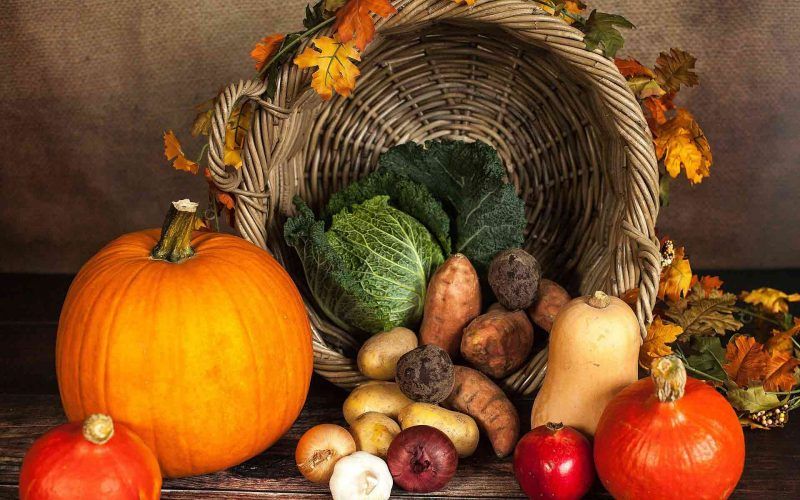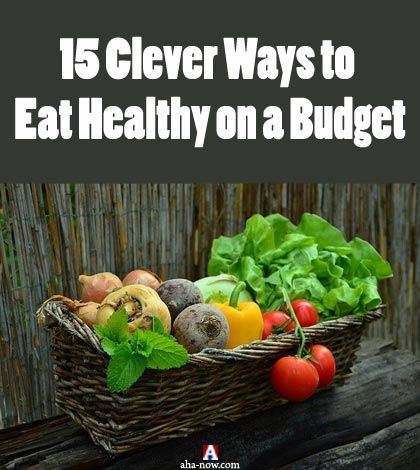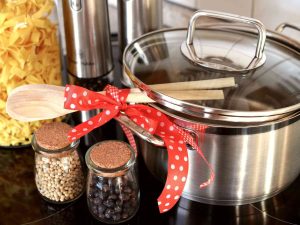15 Clever Ways to Eat Healthy on a Budget

Table of Contents
- 15 Ways to Eat Healthy on a Budget
- Meal Planning
- Stick to Your List
- Start Cooking
- Cook in Batches
- Shop After a Heavy Lunch
- Purchase Whole Foods
- Purchase Generic Brands
- Say NO to Junk Food
- Stock Up During Sales
- Purchase Cheaper Cuts of Meat
- Try Other Sources of Protein
- Purchase Seasonal Items
- Freeze Food Items
- Say Yes to Bulk Buying
- Build a Terrace Garden
- The Takeaway
We know eating healthy leads to a healthy body and mind. But can you eat healthy when you are tight on a budget? Of course, you can. Instead of opting for junk food, purchase vegetables from the market, start your terrace garden, and cook at home. Sounds interesting? Here are more ways to eat healthy on a budget including some smart shopping strategies that you may find quite useful. ~ Ed.

Healthy food is often expensive making it difficult to eat healthy when you’re trying to save. However, there are several ways to save money while eating nutritious food. Here are a few tips that will help you eat healthy on a budget.
15 Ways to Eat Healthy on a Budget
If you want to eat healthy on a budget then one option is to start cooking as that will come out to be cheaper. Even build your own terrace garden! Furthermore, you can use a smart shopping strategy to make sure you’re always within your budget. Know them all here.
Meal Planning
If you want to save money at the grocery store, planning is crucial. The key is to sit down once every week and plan all of your meals for the week.
Take into account all those days you’ll be eating out or ordering in so that you don’t end up buying extra.
Once done, prepare a grocery list accordingly. Another tip is to clean out your cabinets and fridge. This will help you understand what all you have and what you genuinely need.
This way you’ll end up buying things that you really need and will use.
Stick to Your List
While making your grocery list is easy, sticking to it is not. You can easily be tempted by the sales of merchandise and new product launches.
This leads to expensive and unintended purchases that burn a huge hole in your wallet.
As a rule of thumb, shop the perimeter of the grocery store first. This way, you’ll fill your cart with more whole foods.
Steer clear of all unhealthy and processed foods. And if you ever find yourself near such aisles, look for items placed on the highest or lowest shelves. The most expensive products are placed at eye level.
You can also use grocery shopping apps and websites that give you alerts when the sale starts or their prices drop. Some of them even allow you to share lists and save items with multiple shoppers.
Start Cooking
Cooking at home is an excellent way to save money. Make it a habit to cook at least half of your meals at home, if not more.
Generally, the cost of cooking a meal for 4 people is equal to one or two people eating out.
If you’re a student or someone who works multiple jobs, I recommend you cook for the whole week on the weekends.
Related Posts
Cook in Batches
By cooking in batches, you will also keep a track of what you’re consuming.
Additionally, you’ll end up saving a huge chunk of your money (and time!)
Apart from this, I strongly suggest you reuse your leftovers. They can be easily used for lunches, dinners, and even breakfasts.
Leftovers make for great burritos, salads, stir-fries, and stews. All of these foods are great if you’re trying to eat healthy on a budget.
Shop After a Heavy Lunch
When you go grocery shopping on an empty stomach, you end up buying a lot of things on impulse.
You crave unhealthy foods when you’re hungry. With aisles full of processed foods everywhere around you, you surrender and buy things you shouldn’t be eating.
If you’ve had no chance to grab a meal but you have to shop, I suggest you grab a yoghurt or fruit or any other healthy snack of your choice before entering the store.
Purchase Whole Foods
Foods are often cheaper in their less processed forms.
For instance, a whole block of cheese is always cheaper than diced or shredded cheese.
Whole grains such as oats, brown rice are cheaper per serving than processed cereals.
Purchase Generic Brands
All stores have generic brands for almost all products.
It’s a myth that generic brands are of low quality. They might be of a lower quality than premium products but that’s not always the case.
In fact, all manufacturers need to follow a strict set of standards in order to provide foods that are safe for consumption. Generic brands, therefore, are almost identical to all other brands, just less expensive.
It’s wise to read the ingredients to make sure your quality standard is being met.
Say NO to Junk Food
Junk food isn’t only healthy but is also expensive.
You’ll be surprised to see the prices of processed and prepackaged foods, cookies, crackers, and soda.
They provide no or very little nutrition and are full of unhealthy ingredients.
By avoiding such foods, you can spend more on healthy foods of higher quality.
Stock Up During Sales
I always buy staples and my favourite products during the sale. It’s wise to stock up on things you regularly use such as salt, sugar, spices, brown rice, etc.
Check their expiry and best before dates to ensure that they won’t get spoilt by the time you get a chance to use them.
Purchase Cheaper Cuts of Meat
Fish and meat are some of the most expensive items on your bill.
I recommend opting for a flexitarian or a vegetarian diet when you’re trying to eat healthy on a budget.
If not, opt for cheaper cuts of meat and use them in stir-fries, stews, soups, casseroles, and burritos.
It’s also a great idea to buy inexpensive meats in large quantities to use in different meals during the week.
Related Posts
Try Other Sources of Protein
Cutting down on meat doesn’t mean giving up on protein.
Try to eat more canned fish, help seeds, legumes, and eggs. All of them are easy to make, nutritious, and inexpensive. They also have a longer shelf life and are less likely to spoil quickly.
Purchase Seasonal Items
Locally produced food items that are in season are cheaper. They’re at their peak in terms of flavour and nutrients too.
Packed and frozen items generally travel the world before reaching your store which is neither good for you nor the environment.
Buy these items by the bag if possible. Purchasing by the piece is generally more expensive than buying by the bag.
If you end up buying more than what you can consume at that time, simply freeze the remaining portion to incorporate into next week or month’s meal plans.
You can also buy vegetables and fruits from farmers’ markets rather than grocery stores. You’ll be amazed by the quality of your purchase.
Not only is it super fresh (it’s generally plucked at the break of dawn and up for sale by early morning) but also cheaper giving you the best of both worlds.
Freeze Food Items
As I previously pointed out, freeze your remaining fruits and vegetables rather than letting them rot and tossing them in the bin.
Alternatively, you can also stock up on berries and other seasonal foods that are only available for a few months.
Seal them in zip lock bags and freeze them in your freezer. Thaw them a few hours before you wish to consume them to enjoy nutritious foods throughout the year.
You might argue that frozen fruits and vegetables are available at the supermarket. You’ll be surprised to know that you’ll only get half or one-fourth of the quantity for the same price when buying in the offseason.
This will help you enjoy your favourite fruits and vegetables throughout the year without having to worry about spending too much.
Say Yes to Bulk Buying
Bulk buying saves you a lot of money.
Sure, everyone knows that. But how many of us actually buy in bulk?
Buy food items such as oats, barley, brown rice, and other grains in bulk.
They have a decent shelf life when stored in airtight containers. You can also buy and store dried fruits, nuts, lentils, and beans.
These staple foods are not expensive and can be used for several healthy recipes especially for breakfast.
Build a Terrace Garden
While this may not be possible for everyone, try to build one if you can.
Growing your own produce is an excellent way to ensure you consume organic fruits and vegetables.
Organic fruits and vegetables, when purchased otherwise from grocery stores can cost an arm and a leg.
However, seeds barely cost anything. With a little effort and a few hours per week, you can grow your own crops.
If you’re new to gardening, then reading gardening books for dummies will help you learn everything you need to know.
Start small with crops like onions, tomatoes, sprouts, and herbs. They’re easy to grow and require very little supervision.
Apart from saving you money, a continuous supply of produce at home will save you a shopping run every week.
You’ll also notice that homegrown produce tastes better and has a longer shelf life.
The Takeaway
You don’t have to break the bank to eat healthily.
There are several ways to eat healthy on a budget. Start by planning your meals, growing your own produce, and cooking more often.
Make smart purchasing choices when at the grocery store and stay away from processed and junk foods.
Remember that with bad health come big medical bills.
Even if eating healthy was expensive (not if you’re following our tips), it’d still be worth it in the longer run.
I mean, you really can’t put a price on good health, can you?
Over to you
Do let us know which tips did you follow and how much did it help you save in the comments section below!
Disclaimer: Though the views expressed are of the author’s own, this article has been checked for its authenticity of information and resource links provided for a better and deeper understanding of the subject matter. However, you're suggested to make your diligent research and consult subject experts to decide what is best for you. If you spot any factual errors, spelling, or grammatical mistakes in the article, please report at [email protected]. Thanks.



















I’m glad you found these tips informative, Anirban.
Good and valuable information. I would try to implement these in my regular routine.